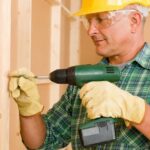Are you wondering “can I refinance for home improvements“? Refinancing for home improvements is a popular option for homeowners looking to fund renovation projects. This article will explore the concept of refinancing for home improvements, the benefits it offers, the different types of refinancing options available, eligibility requirements, steps to take when considering a refinance, important considerations before making a decision, tips for a successful refinance, and real-life success stories.
By refinancing for home improvements, homeowners have the opportunity to not only update and enhance their living space but also increase the value of their property. This can lead to significant long-term benefits such as saving money on utility bills and potentially selling the property at a higher price in the future. Whether it’s a kitchen remodel, bathroom upgrade, or adding an extension, refinancing can provide the necessary funds to carry out these home improvement projects.
In this article, we will delve into the various types of refinancing options available for financing home renovation projects, including cash-out refinance and renovation loans. We will also outline the eligibility requirements that homeowners need to meet in order to qualify for a refinance, along with providing a step-by-step guide on how homeowners can go through the refinance process successfully.
Benefits of Refinancing for Home Improvements
Refinancing for home improvements can be a smart financial move for homeowners looking to save money and increase the value of their property. By taking advantage of lower interest rates or tapping into their home’s equity, homeowners can fund renovation projects without breaking the bank. Below are some of the key benefits of refinancing for home improvements:
- Lower Interest Rates: Refinancing allows homeowners to secure a new mortgage with a lower interest rate than their current one. This can result in significant long-term savings, especially if the original mortgage was taken out when interest rates were higher.
- Access to Home Equity: Homeowners who have built up equity in their property may be able to use a cash-out refinance to access this equity and fund home improvement projects. This can provide a cost-effective way to pay for renovations, as the interest rates on mortgage loans tend to be lower than those on personal loans or credit cards.
- Increase Property Value: Investing in home improvements through refinancing can lead to an increase in the overall value of the property. This is particularly beneficial for homeowners who plan to sell in the future, as it can result in a higher resale value and potentially attract more buyers.
With these benefits in mind, refinancing for home improvements can offer significant financial advantages for homeowners looking to enhance their living spaces and increase the value of their properties over time. It’s important for homeowners to carefully consider their options and weigh the potential savings and increased property value against any associated costs or risks before deciding whether to refinance for home improvements.
Types of Refinancing Options for Home Improvements
Refinancing for home improvements is a great way for homeowners to fund renovation projects while potentially saving money in the long run. There are several types of refinancing options available that homeowners can consider when looking to finance their home renovation projects.
One popular option is a cash-out refinance, which allows homeowners to refinance their mortgage for more than they currently owe and receive the difference in cash. This extra cash can then be used for home improvements, such as remodeling the kitchen or adding a new bathroom. This type of refinancing can be beneficial because it often comes with lower interest rates compared to other types of loans, and the interest may be tax-deductible.
Another option is a home equity loan, which allows homeowners to borrow against the equity they have built up in their home. This type of loan provides a lump sum of money upfront that can be used for renovations, and it typically comes with a fixed interest rate, making it easier to budget for monthly payments. Home equity loans may be a good option for larger renovation projects with substantial costs.
Additionally, homeowners can also consider a home equity line of credit (HELOC), which works similarly to a credit card in that it provides homeowners with access to a line of credit based on their home’s equity. With a HELOC, homeowners can borrow as much or as little as they need for their renovation projects and only pay interest on the amount they use. This flexibility can be advantageous, especially for ongoing projects with fluctuating costs.
Considering these various options, homeowners should carefully evaluate their financial situation and renovation needs before deciding on the best refinancing option for their home improvements.
| Refinancing Option | Description |
|---|---|
| Cash-Out Refinance | Allows homeowners to refinance for more than they owe and receive the difference in cash |
| Home Equity Loan | Enables homeowners to borrow against the equity in their home with a lump sum upfront |
| Home Equity Line of Credit (HELOC) | Provides access to a line of credit based on the home’s equity, allowing borrowers flexibility in borrowing for renovation projects |
Eligibility Requirements for Refinancing for Home Improvements
Refinancing for home improvements can be a great option for homeowners looking to upgrade their property or make necessary repairs. However, it’s important to understand the eligibility requirements that need to be met in order to qualify for a refinance. Whether you’re considering a cash-out refinance or a home equity loan, there are certain criteria that lenders typically look at before approving a refinance for home improvements.
Here are some eligibility requirements that homeowners need to meet in order to qualify for refinancing for home improvements:
- Sufficient equity in the property: Lenders will typically require homeowners to have a certain amount of equity in their property in order to qualify for a refinance. This is because the equity serves as collateral for the new loan.
- Good credit score: A good credit score is crucial when applying for a refinance, as it demonstrates your ability to manage debt responsibly. Lenders will typically look for a credit score of 620 or higher, although this may vary depending on the lender and the type of loan you’re applying for.
- Stable income and employment history: Lenders want to see that you have a stable source of income and a consistent employment history. This helps reassure them that you’ll be able to make your monthly payments on time.
Meeting these eligibility requirements is essential if you want to qualify for refinancing for home improvements. By ensuring that you meet these criteria, you can increase your chances of getting approved for a refinance and access the funds needed to enhance your property. Keep in mind that every lender may have slightly different requirements, so it’s always best to shop around and compare offers before making a decision on how best to proceed with your refinancing plans.
Steps to Refinance for Home Improvements
Refinancing for home improvements can be a great way for homeowners to leverage the equity in their property to fund renovation projects, but it’s important to understand the process and carefully consider all options before moving forward. Here are some steps to guide homeowners through the refinance process for home improvements:
1. Assess your current financial situation: Before diving into the refinance process, it’s crucial to take stock of your current financial situation. This includes evaluating your credit score, debt-to-income ratio, and overall financial stability. Lenders will consider these factors when determining your eligibility for a refinance, so it’s important to ensure that your finances are in good shape.
2. Research different refinancing options: There are various refinancing options available for homeowners looking to fund home improvement projects. These may include cash-out refinancing, home equity loans, or home equity lines of credit (HELOCs). It’s essential to research and compare these options to find the best fit for your specific needs and goals.
3. Shop around for the best lender: Once you’ve decided on the type of refinance that suits your needs, it’s time to shop around for the best lender. Compare interest rates, closing costs, and terms offered by different lenders to ensure that you’re getting the most favorable deal possible.
In addition, homeowners should also factor in any additional costs associated with their renovation project when considering a refinance option since this could impact their ability to repay a loan on time.
| Step | Description |
|---|---|
| Assess Your Financial Situation | Evaluate credit score, debt-to-income ratio, and overall financial stability. |
| Research Refinancing Options | Explore cash-out refinancing, home equity loans, or HELOCs. |
| Shop Around for Lenders | Compare interest rates and terms offered by different lenders. |
Considerations Before Refinancing for Home Improvements
When considering refinancing for home improvements, there are several important factors that homeowners need to take into account before making a decision. Refinancing can provide the funds needed for renovations, but it’s essential to carefully weigh the pros and cons to determine if it’s the right choice for your specific situation.
Current Interest Rates and Loan Terms
One of the most critical factors to consider before refinancing for home improvements is the current interest rates and loan terms. Make sure to compare the interest rates you’re currently paying on your mortgage with the rates available for refinancing.
Additionally, consider the length of the loan term and how it will impact your overall financial situation. It’s also important to calculate how much you could potentially save by refinancing, taking into account any closing costs or fees associated with the new loan.
Equity in Your Home
Another consideration before deciding to refinance for home renovations is the amount of equity you have in your home. Equity is the difference between the market value of your property and the balance remaining on your mortgage. The more equity you have, the more favorable terms you
Overall Financial Situation
Before pursuing a refinance for home improvements, take a close look at your overall financial situation. Consider factors such as your credit score, debt-to-income ratio, and any other outstanding debts or financial obligations.
It’s important to ensure that you’re in a strong financial position before taking on additional debt through a refinance. Additionally, consider how long you plan to stay in your current home and whether or not it makes financial sense to invest in renovations at this time.
By carefully considering these factors before deciding to refinance for home improvements, homeowners can make an informed decision that aligns with their financial goals and circumstances. Refinancing can be a valuable tool for funding renovation projects, but it’s important to conduct thorough research and consult with financial professionals if necessary in order to make the best choice for your individual situation.
Tips for a Successful Refinance for Home Improvements
When it comes to refinancing for home improvements, there are several tips that homeowners can consider in order to maximize the benefits of this financial decision. By following these tips, homeowners can ensure that they make the most out of their refinancing for home renovation projects.
Shop Around for the Best Rates
One of the most important aspects of refinancing for home improvements is to shop around for the best rates. Different lenders offer different interest rates and terms, so it’s essential to compare offers from multiple sources before making a decision. By securing a lower interest rate, homeowners can save money in the long run and decrease the overall cost of their home renovation project.
Consider the Loan Term
Another tip for a successful refinance for home improvements is to carefully consider the loan term. While a shorter loan term may result in higher monthly payments, it can save homeowners money on interest over time.
On the other hand, a longer loan term may result in lower monthly payments but could end up costing more in interest. It’s important to weigh the pros and cons of each option and choose a loan term that aligns with your financial goals.
Use Funds Wisely
Once homeowners have secured a refinance for home improvements, it’s crucial to use the funds wisely. Allocating funds towards high-value renovations that can increase the overall value of the property is a smart investment. This might include kitchen or bathroom upgrades, adding square footage, or enhancing curb appeal. By strategically using the funds from a refinance, homeowners not only improve their living space but also potentially increase their property’s resale value down the line.
Case Studies and Success Stories
In conclusion, refinancing for home improvements can be a beneficial option for homeowners looking to save money and increase the value of their property. By choosing the right refinancing option, homeowners can secure funds at a favorable interest rate, allowing them to tackle renovation projects without breaking the bank. Additionally, the increased value of their property as a result of the renovations can lead to potential financial gains in the future.
Exploring different loan options available for financing home renovation projects is essential. Whether it’s a cash-out refinance, home equity loan, or home equity line of credit, homeowners have various choices when it comes to refinancing for home improvements. Understanding the eligibility requirements and considering factors such as credit score, debt-to-income ratio, and home equity will help homeowners determine if they qualify for a refinance and which option suits their needs best.
Furthermore, seeking advice from financial experts and researching market trends can provide valuable insights before making a decision about refinancing for home improvements. By carefully evaluating all options and understanding the impact of a refinance on their overall financial situation, homeowners can make informed decisions that will ultimately benefit them in the long run. With proper planning and consideration, refinancing for home improvements
Frequently Asked Questions
Can You Refinance Home for Renovations?
Yes, you can refinance your home for renovations by taking out a new mortgage that includes the cost of the renovations. This will allow you to access the equity in your home to fund the renovation project.
Can I Refinance My Home to Build an Addition?
Refinancing your home to build an addition is possible. By refinancing, you can access the equity in your home and use the funds to finance the construction of an addition. This allows you to pay for the addition over time through your mortgage payments.
Can You Borrow More for Home Improvements?
If you have enough equity in your home, you may be able to borrow more for home improvements by refinancing your mortgage. This can give you access to additional funds that can be used for a variety of home improvement projects, such as kitchen renovations or bathroom upgrades.

I’m thrilled to have you here as a part of the Remodeling Top community. This is where my journey as an architect and remodeling enthusiast intersects with your passion for transforming houses into dream homes.





